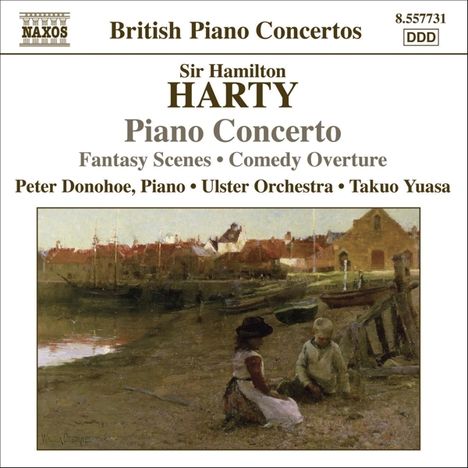Hamilton Harty: Klavierkonzert h-moll auf CD
Klavierkonzert h-moll
Herkömmliche CD, die mit allen CD-Playern und Computerlaufwerken, aber auch mit den meisten SACD- oder Multiplayern abspielbar ist.
Lassen Sie sich über unseren eCourier benachrichtigen, falls das Produkt bestellt werden kann.
+A Comedy Overture; Fantasy Scenes
- Künstler:
- Peter Donohoe, Ulster Orchestra, Takuo Yuasa
- Label:
- Naxos
- Aufnahmejahr ca.:
- 2005
- UPC/EAN:
- 0747313273126
- Erscheinungstermin:
- 30.1.2006
- Serie:
- Naxos British Piano Concertos
Ähnliche Artikel
A Comedy Overture, 1906 komponiert und 1907 bei einem Promenadenkonzert in der Queen's Hall uraufgeführt, war eines der Werke, die Harty als Komponist weiter bekannt machten. Der Titel spiegelt lediglich den lebendigen Charakter der Musik wider und impliziert keine theatralische Verbindung. Es gibt zwei Hauptthemen: Das erste ist nach der lebhaften Einleitung auf der Oboe zu hören und durchzieht mit seinem schwungvollen Rhythmus einen Großteil der Musik; das zweite ist langsamer und wird zuerst auf den Holzbläsern gespielt. Zwei Beispiele müssen genügen, um die abwechslungsreiche und phantasievolle Art und Weise zu veranschaulichen, in der Harty mit diesen Themen umgeht. Das eine kommt am Ende des Durchführungsteils vor, wo die Piccoloflöte (über einem Dudelsack-Dröhnen auf den Fagotten) mit einer Reprise des ersten Themas in der "falschen Tonart" beginnt. Es bleibt dann dem Pauker überlassen, die richtigen Töne herauszuschlagen und den Weg für die eigentliche Reprise auf der Klarinette vorzubereiten. Das andere Beispiel tritt später im Stück auf, wenn das zweite Thema auf den Celli erklingt, wobei die Harmonien am subtilsten verändert werden.
Fantasy Scenes (From an Eastern Romance) wurde 1919 komponiert und im folgenden Jahr vom Hallé uraufgeführt. Es malt das konventionelle Bild des Ostens aus "Tausendundeiner Nacht", das zu jener Zeit populär war, wie es in der Musik durch Rimskij-Korsakows Scheherazade berühmt wurde.
Harty's Klavierkonzert in h-Moll wurde 1922 in Fiesole in Italien komponiert, während der Komponist bei den Espositos wohnte. Harty war der Solist (Beecham dirigiert) bei der Uraufführung im darauf folgenden Jahr, und die Bravour, mit der er für das Soloinstrument schrieb, erinnert daran, was für ein hervorragender Pianist er war. Das Werk steht ganz in der Tradition der Romantik, mit Schattierungen von Rachmaninow im Klavier- und Orchestersatz, den Chromatiken, den betörenden Gegenmelodien und dem Hauch verweilender Melancholie.
Product Information
A Comedy Overture, composed in 1906 and first performed at a Queen’s Hall Promenade Concert in 1907, was one of the works which brought Harty to wider notice as a composer. The title simply reflects the lively character of the music, and does not imply any theatrical connection. There are two main themes: the first is heard on the oboe after the bustling introduction, and its jaunty rhythm pervades much of the music; the second is slower and is first heard on the woodwind. Two instances must suffice to illustrate the varied and imaginative way in which Harty treats these themes. One occurs at the end of the development section, where the piccolo (over a bagpipe drone on the bassoons) embarks on a recapitulation of the first theme in the ‘wrong key’. It is then left to the timpanist to beat out the right notes and prepare the way for the real recapitulation on the clarinet. The other example occurs later in the piece, when the second theme is heard on the cellos with the harmonies most subtly altered.
Fantasy Scenes (From an Eastern Romance) was composed in 1919 and first performed by the Hallé the following year. It paints the conventional ‘Arabian Nights’ picture of the East which was popular at that time, as made famous in music by Rimsky-Korsakov’s Scheherazade.
Harty’s Piano Concerto in B minor was composed at Fiesole in Italy in 1922 while the composer was staying with the Espositos. Harty was the soloist (Beecham conducting) in the first performance the following year, and the bravura writing for the solo instrument is a reminder of what a fine pianist he was. The work is very much in the Romantic tradition, with shades of Rachmaninov in the piano and orchestral writing, the chromaticisms, the beguiling countermelodies, and the air of lingering melancholy.
Disk 1 von 1 (CD)
-
1 A Comedy Overture
-
2 Fantasy Scenes on an Eastern Romance: I. The Laughing Juggler
-
3 Fantasy Scenes on an Eastern Romance: II. A Dancer#s Reverie
-
4 Fantasy Scenes On An Eastern Romance: Iii. Lonely In Moonlight
-
5 Fantasy Scenes on an Eastern Romance: IV. In the Slave Market
-
6 Piano Concerto in B minor: I. Allegro risoluto
-
7 Piano Concerto in B minor: II. Tranquillo e calmo
-
8 Piano Concerto In B Minor: Iii. Con Brio E Vivace
Mehr von Hamilton Harty
-
Hamilton HartyIrish SymphonyCDAktueller Preis: EUR 14,99
-
Hamilton HartyOrchesterwerke3 CDsVorheriger Preis EUR 37,99, reduziert um 0%Aktueller Preis: EUR 22,99
-
Daisy Kennedy - The Complete British Columbia and Duophone Recordings2 CDsAktueller Preis: EUR 24,99
-
Katharina Sames & Mari Inoue - Nordic TreasuresCDAktueller Preis: EUR 19,99








